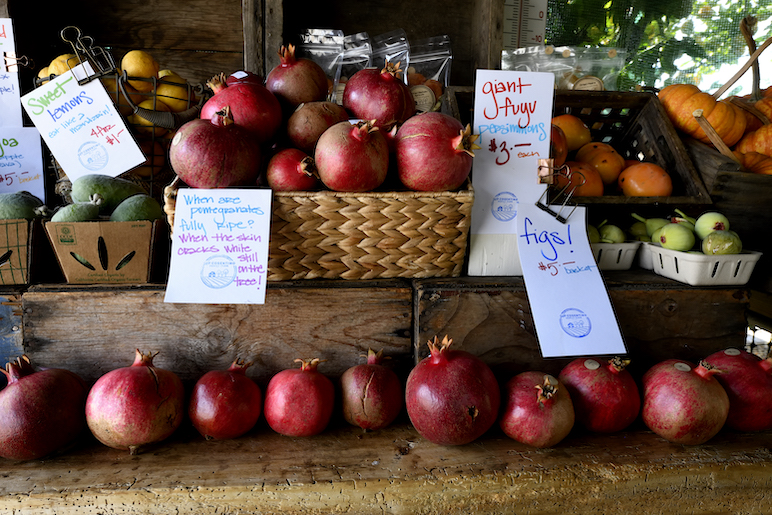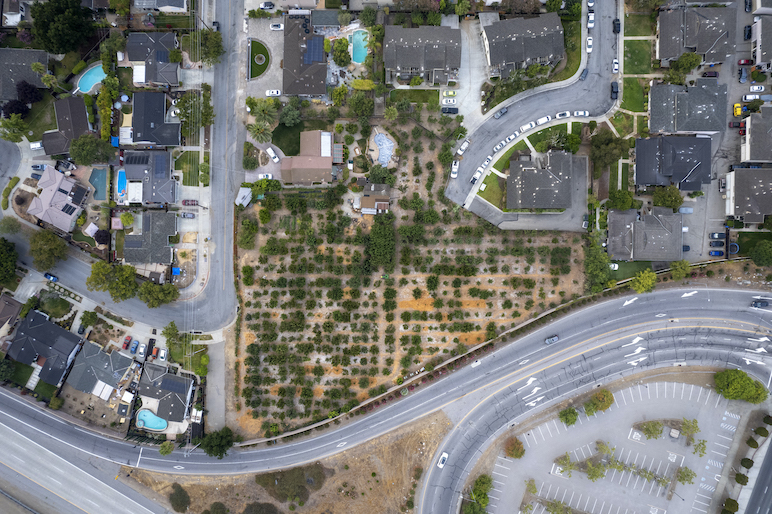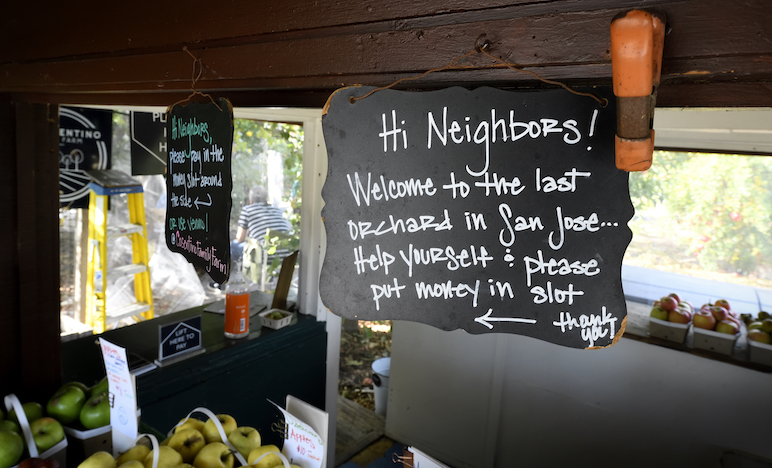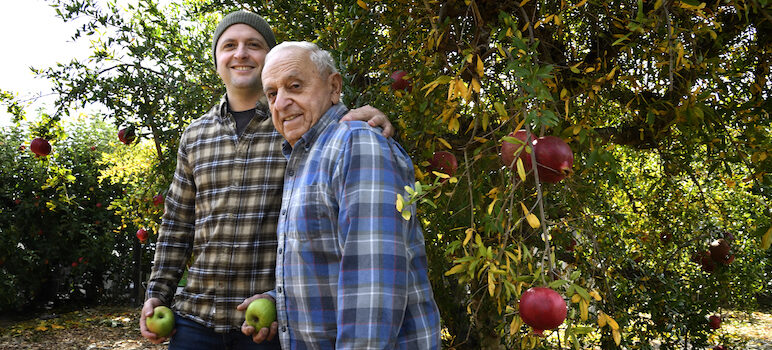If you’ve never considered how essential J&P Cosentino Family Farm is to the very identity of the South Bay, you’re not alone. In fact, the history of the farm—now just a tiny two acres surrounded on all sides by the sprawling metropolis that is Silicon Valley—is one of being under-appreciated, unloved and counted out.
And yet, this oasis of some of the world’s most exquisite fruit, this orchard that provides one of the last remaining links to Santa Clara County’s history as the agricultural mecca dubbed the “Valley of the Heart’s Delight” by John Muir, continues to survive and thrive after three-quarters of a century.
It has outlasted the development-driven government officials who plowed Highway 85 through the plot in 1994, cutting it down to less than a quarter of its size. The farm has weathered decades of tech development that brought shiny high-rises to San Jose and ag-land-swallowing, condominium-building fever to the suburbs. And generation by generation, it’s won over each member of the Cosentino family that owns and stewards it—despite the fact that they all started out resenting and even flat-out rejecting the farm at the heart of their family’s legacy.
That includes 90-year-old Phil Cosentino, the man who would come to make the farm his life’s work. He was a teenager when his father first purchased the land in 1945—and back then, he wanted nothing to do with it.
“I hated, hated this place,” says Phil, sitting on a bench on the edge of the orchard, where the branches of the trees that produce local favorites like Babcock peaches and Santa Rosa plums are now bare, but others are bursting with pomegranates, persimmons and other post-summer fruits. “My father bought 10 acres, but he actually wanted to buy more. He wanted to buy 100 acres. And he had looked at other properties, but decided that wasn't going to happen, because the four of us—me and my three brothers—we hated working here. We were arguing with him all the time. 'We don't want to work here, we don't want to work here.' So my mother told my father, ‘You know, you better find something for these kids to do, because they're going to leave.’”

90-year-old Phil Cosentino was a teenager when his father first purchased the land in 1945—and back then, he wanted nothing to do with it. Photo by Greg Ramar
In other words, it’s no coincidence that the family opened the first Cosentino’s Market in 1948. Phil and his brothers did run the markets—which unsurprisingly specialized in top-of-the-line produce, and expanded into three stores around the South Bay—for 63 years; the last Cosentino’s, on South Bascom Avenue, closed in 2011.
But for Phil, something fundamental changed during that time. In the early ’70s, he and his wife Jean (the “J&P” in the farm’s name) built a home on the family’s 10 acres. Almost all of the fruit trees there had already been razed, and the land was slated for development. But Phil—who had always liked to grow things, but found himself too busy at the market—was beginning to have a change of heart. It came to a head after he read a story in the newspaper about a man who wanted to start a little farm, but was caught up in bureaucratic red tape.
“It was a real tearjerker of a story,” he says. “I told my wife, ‘You know, we have what this guy would die for, and we're letting it go. I really like this place the way it is.’”
By that time, Phil and his brothers had split ownership of the land four ways, and when he told them he wanted to buy them out, they thought he was crazy. But buy them out he did, and that same year he began transforming the Cosentino land into a farm again.
“The first year I probably planted maybe 70 or 80 trees, and then every winter I'd plant more,” he says.
Today, there are 552 trees in all, and the urban farm that Phil made his passion project half a century ago is now changing hands again, as his daughters Kari Cosentino, Janine Cosentino and Mary Forman take over ownership of the J&P Cosentino Family Farm.
Among the many things the farm has survived are decades of general consumer indifference to where their fruit is grown and how it tastes, and to the fact that they are living on top of some of the most incredible fruit-producing soil in the world. Now that is shifting, as a new generation of foodies and Community Supported Agriculture (CSA) fanatics spread word of Cosentino’s unique (and Instagram-ready) plums, pluots, apricots, apples and other fruits across social media and by word of mouth.

Though the farm is busiest in the summer, it produces fruit year-round. Current offerings include pomegranates, apples, figs and more. Photo by Greg Ramar
Kari says that although she and her sisters now have their own lives and careers, they have all come back to manage and work at the farm because the alternative would be to sell it—probably to developers—and “we could never let that happen.” She’s watched the last remaining orchards in other parts of the South Bay be sold off, one by one, and it disturbs her.
“What will we have left?” she asks. “Where's this area’s charm and heart, without some connection to the past? I think that is where San Jose has lost so much of its identity.”
Stand in the Place Where You Live
With the stores long gone, locals now discover J&P Cosentino Family Farm through its fruit stand on Carter Avenue, at the edge of the orchard now squished between residential homes in the Cambrian neighborhood and Highway 85 near the Camden Avenue exit. It’s been there for decades, and Phil explains that it's been added to and upgraded four times over the years.
“It started real little, and then got bigger and bigger—bigger this way, bigger that way,” he says. “I built this for Mary and Kari when they were in grammar school. It wasn't for me, I was working full time. I grew the fruit, and we sold a lot of it at the store, but it gave them something to do. And this is what they did all through grammar school, high school.”

An aerial view of the J&P Cosentino Family Farm, which was scaled back significantly in the early ’90s to make room for Highway 85. Photo by Greg Ramar
Like their father, Mary and Kari weren’t exactly thrilled by farm work when they were kids.
“I don't remember a time when we weren't working in the orchard,” says Mary. “Kari and I joke we were like complete slave child labor out there. I remember being out there in the summer, and as kids, we thought everything was the worst ever. You know, 150 degrees, out there for 18 hours—it wasn't, and we weren’t, but that's how it felt as a kid.”
“Summer was working at the fruit stand,” says Kari of growing up in the early ’80s. “My sister and I would sit on the lawn, play Monopoly and run out when there was a customer. And my parents let us buy all the ice cream we wanted from the ice cream man. Every day, we'd buy a ton of ice cream and gum—that was our payment for working. And that was every summer, besides doing tasks we didn't like to do like cutting apricots and packing peaches. You know, very sticky and dirty, dirty work. Back then we had metal irrigation pipes that we would move through the orchard when we needed to irrigate. And so my sister and I—I mean, I remember being, like, eight and helping to move irrigation pipes. And we didn't have any mulch down, so it was just dirt and mud up to your knees. Well, as a kid, it's like mud up to your thighs. We would lose shoes and our parents would be like, ‘Where are your shoes?’ ‘Well, they’re somewhere in the orchard in the mud. They came off a long time ago.’”
But also like their father, their attitude about life on the farm has shifted dramatically over the years.
“I mean, we bitched about it all the time, but looking back on it, that was amazing stuff,” says Mary. “Kids didn't get to do that. There was the work part, but it was also, like, our playground.”
For Janine, it’s different. She was the child of Phil’s previous marriage, and her parents divorced when she was three. By the time Phil replanted the orchard, Janine was a teenager, living with her mom in Los Gatos. She did work in the markets, and visited the orchard, but after high school, she got married and moved away, and didn’t return to the area until the 2000s. So her devotion to the farm now is not so much about the time she had there as the time she didn’t have.
“I love spending time with my dad that I didn't get to spend with him growing up,” she says. “I could sit out there with him for hours. Like today, I will sit out probably on this bench in the garage or whatever, and chat for a good hour, because now I cherish that time. I just realized that, you know, I missed so much.”

Though the farm is busiest in the summer, it produces fruit year-round. Current offerings include pomegranates, apples, figs and more. Photo by Greg Ramar
All of these factors have fostered a fiercely protective attitude among the sisters. The passage of Proposition 19 last year made it clear to everyone involved that the land would have to be put in their names immediately—if they hadn’t gotten the transfer done, they would have had to sell the land when their parents passed, Kari says, because they could never have afforded the taxes. They were ready.
“I look at the orchard like a family member. It would be inconceivable to not keep it going, because we have this treasure that's been given to us,” says Mary. “And my dad has cared for it and loved it, and put in more hours than we could possibly ever imagine. And if we can find the right path to keep it going, that’s an honor to do so.”
“The thought of that not being here, I wouldn't be able to live with myself,” says Kari. “I think I’d have to move out of the country.”
“At first I said, ‘You girls are crazy!’” says Janine with a laugh. “Because I’m 15 years older, you know?” But she came around after remarrying and retiring. “That became the avenue for me to work more with my dad. Whatever makes him happy and makes life easier for him, I’m all for. I kid with the girls that I’m much older, and I will be retiring from all this hard work much earlier. But I want to see it go on.”
“You look around, and this doesn't exist anywhere,” says Mary. “So it’s not just for our family, but for others to come and experience it. It never ceases to amaze me. Whenever I'm working [at the stand], there's always at least one person who stops by and has never been there before, and it blows their mind. ‘I had no idea that this even existed.’ I tell them, ‘You're welcome to walk through at your own risk,’ and they’re just like, ‘This is the most amazing thing, and you need to keep this going.’”
The Chemistry of the Heart’s Delight
Certainly the J&P Cosentino farm is unique in the sheer number and diversity of the varieties of produce they grow in the South Bay—many are heritage fruits for this area, and quite a few are not available commercially. (The most recent of these to find a following locally is the Warren pear, which Phil started growing on a whim and now sells out as quickly as the family can pick them, just like the Baby Crawford peaches, the Santa Rosa plums and several other varieties).
But why is fruit from the Valley of the Heart’s Delight, even today, so delicious?
“The fruit from this region, you can't beat the taste,” says Phil. “People ask, 'How come your fruit tastes so good compared to the stores?' And I tell them 'It's where they grow.' It's not that we have any magic wand, it's the soil. I remember when I was a kid, my father would say, 'This is the best dirt in the world.' I'd say, 'Yeah, right, pop, best dirt in the world.' But he was right. He didn't know why it was the best. But he was right."

The farm stand where J&P Cosentino Family Farm sells its produce has drawn a whole new legion of followers in the Instagram age. Photo by Greg Ramar
These days, we do know why. The soil here is not only nutrient-rich, it also retains water to a remarkable degree, which allows South Bay farmers to use a method known as “dry farming”—very little irrigation required. Much of the fruit you’ll find in supermarkets, Phil explains, comes from the Central Valley, which is basically a converted desert that requires a lot more irrigation. The fruit absorbs that extra water, diluting the taste.
“The very first oranges that were planted in the West, they were planted in the city of Campbell. Because when the settlers came here, they recognized what it was here, the soil. This is what we call loamy clay,” says Phil. “Loamy clay has water-holding capacity. Now, all the farms over in the Central Valley, it’s all sand. Water just goes right through, so that's why they have to water so often. A farmer years ago that was visiting over here [from the Central Valley] asked me how often I watered. I said, ‘Well, about every 30 days.’ ‘Oh,’ he says, ‘our place over there, we have to water every seven days.’ Because that soil doesn’t hold the water. We’ve found over the years that the more water you give fruit, the less flavor you have.”
The Next, Next Generation
Megan Alpert, an agricultural communications expert who wrote her SJSU thesis on the shift in how farming in Santa Clara County has been portrayed in the media over the last century—and who also grew up on a local farm family—says there’s a reason that small farms like J&P Cosentino are growing in popularity in urban areas like San Jose.
“I think that there's something about purchasing food locally that really appeals to people. There’s also an element of storytelling, and getting to know the stories of the people that are involved in producing our foods,” she says. “Storytelling is so ingrained in us as humans, and we connect that way.”
Phil, obviously, has all the stories, and he’s still very active at both the stand and the orchard—just ask the sisters, who are regularly trying to keep him off ladders and tractors. But as he steps aside, they will be called on more and more to share their own stories, and to find new ways to connect with local customers.
One thing they’ve done already is bring in yet another generation of the family, Janine’s son Jason Cosentino, a former chef who has been creating products like jams, syrups, granola and more using the farm’s fruit.
Like the generations before him, Jason had to come around to understanding the farm’s importance.
“I started at a young age working at the farm,” he says. “I was probably around 11, 12, when my grandfather gave me a pitchfork and I was shoveling manure. So probably at the time I didn't appreciate it like I do now, as I’m older and looking back. But now I get to learn from my grandfather, who has tons of knowledge in growing produce, selling produce, and then also the culinary side as well.”

“Welcome to the last orchard in San Jose,” reads a sign posted above the farm stand. Photo by Greg Ramar
Jason says he’s found fans of the fruit stand have plenty of ideas about what they want.
“Customers say ‘Oh, are you going to make a strawberry jam? Are you going to make olallieberry?’ They’ll give us feedback on what they’re looking for,” he says. “I want to give them something that is really down-to-earth good that they know. But I also want to be innovative and different. Like candy kumquats, that was one of our first items. That’s not something new, but I infuse it with bourbon. So, you know, kind of putting some tweaks in different flavor profiles, and being mindful of not overpowering the pure ingredient.”
Because that fruit at the heart of each of his creations, says Jason, is the show.
“The produce we grow is just so phenomenal. I want to transform it so if it’s pickled or it’s jammed or canned, they can have it throughout any season, and still enjoy the same experience as if it was summer. Our fruit makes my job a lot easier, because when I’m making these products, jams or whatnot, I don't need to sweeten them up with other ingredients. There’s already tons of flavor. So it’s very minimal ingredients—my jam has less than five ingredients.”
Janine is proud to have him involved. “He’s got the creativity that probably I wouldn't have,” she says. “And so do Kari and Mary—I kind of say they're the creativity of the orchard, and I'm the workhorse. You know, just tell me what you want me to do.”
Kari says what Jason is bringing to the business is one example of how it can expand in the future.
“I’d like to see us build out, and have people be able to appreciate having an urban farm in their neighborhood—being able to experience it more than just buying our fruit. I want them to learn how to prune. I want them to learn how to plant a tree. I want them to learn how to cook with persimmons from Jason. I want them to come here for an apple-tasting event. It’s one thing to have something like this, and you drive past and you might stop and buy something. It’s another thing to say, ‘I had an experience there,’” she says. “And I think that's what we haven’t done.”
As he looks out over the orchard he has nurtured for 50 years, Phil seems confident that these two acres will never suffer the fate that befell the tens of thousands of acreage that once made Santa Clara County the largest producer of fruit in the state. After years of being under-appreciated, his land has new generations of family members to care for it—and new generations of customers to discover the importance of the best dirt in the world.
J&P Cosentino Family Farm is open year-round at 4977 Carter Avenue in San Jose. They update what varieties are for sale at their stand regularly at facebook.com/CosentinoFamilyFarm.


They have yard sale -like signs out on Camden Ave directing you to the farm stand. Look for them, you can’t miss ’em.
This is a great story, well documenting the last family orchard. Over in Evergreen, there used to be the Cortese’s cherry orchard, but those are now cookie cutter single family homes right across the creek from Evergreen Valley College. When I was younger, back when the vineyard was still there, I knew some of the Mirassou kids. But I think they also grew mushrooms, too. Hmmm…
Nearly 50 years ago I came to the valley looking for work, I got a job as an electrician at Stokley Van Camps frozen food plant on Newhall Street. We worked that plant 24-7 during the processing seasons
mostly vegetables grown in and around the valley, hard hot a sweaty work. I bought my first house over on the east side, I was amazed at how well the fruit trees grew here orange, lemon, apples, cherries, olive, avocados, peach, tomatoes and many other things grew in the very heavy clay like soil. It’s a shame we have covered all that wonderful dirt and warm climate that turned the Valley of Harts Delight
into the Silicon Valley of no Hart at all!
Sooo sad that this land that could be so productive was lost.